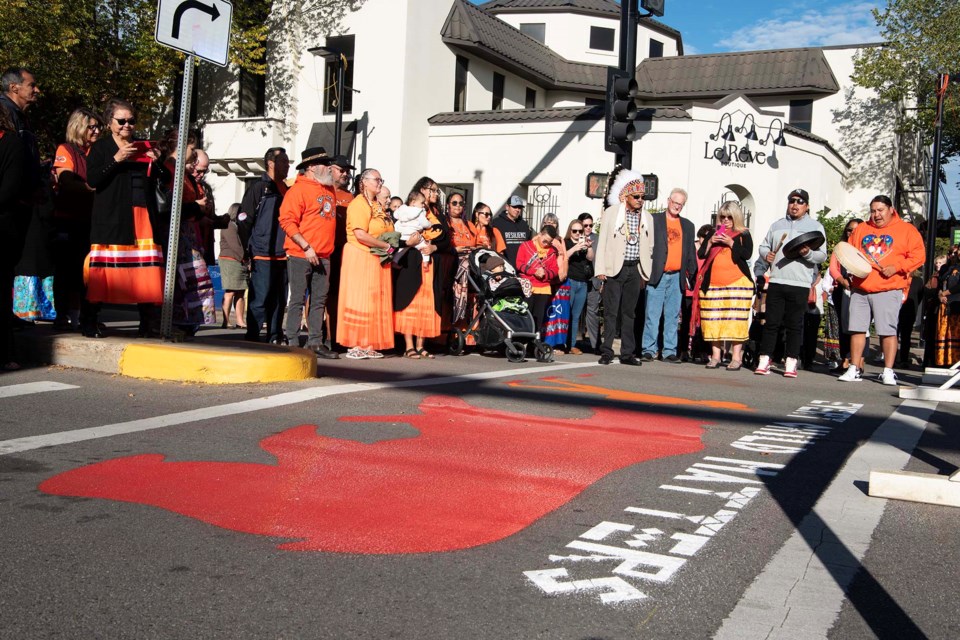St. Albert’s newest crosswalk points right at Mission Hill, once home to one of St. Albert’s two residential schools.
Artist Karlliea Wood hopes those who see the crosswalk make that connection.
“I think it’s really important that people recognize the pain of our past so we can move forward,” she said.
Wood, a Guyanese Cree Ojibwe Métis artist from Edmonton, was one of about 120 people who were at St. Albert Place Sept. 24 to witness the unveiling of St. Albert’s first crosswalk dedicated to Every Child Matters (the national residential school awareness campaign linked to Orange Shirt Day). She designed the crosswalk, which was painted by city crews late on Sept. 23 on the east and west sides of the Perron St./St. Anne St. intersection.
It’s the perfect place for the crosswalk, given that you can see the former site of the Youville school from it, said Mayor Cathy Heron.
“It’s a reminder of our complex history [with residential schools] and our efforts to make amends.”
Heron said unveiling this crosswalk was one of her proudest moments as a mayor, and one of the city’s ongoing efforts to advance truth and reconciliation. She implored residents to treat the crosswalk with respect, adding that crews would repaint it every year.
The crosswalk
Project organizer Rhonda Wood-Viscarra said she got the idea for this crosswalk about two years ago when she asked the City of St. Albert why the community did not have any crosswalks dedicated to Every Child Matters. Hearing that no one had asked for one, she worked with the city and St. Albert–Sturgeon County Métis Nation Local #1904 to make it happen.
“My initial ask was for just over 30 crosswalks,” she noted — one at every school and St. Albert Place — but she settled for one after the city said 30 was too many.
Wood-Viscarra said organizers held a contest to find an Indigenous artist to design the crosswalk. Her daughters, Keisha and Karlliea Wood, ended up being the only entries, and Karlliea was dubbed the winner. (Wood-Viscarra recused herself from judging the contest.)
Wood said her design depicts an Indigenous boy and girl following the footsteps of a bear, as a bear walks behind them. The children are coloured orange in reference to Orange Shirt Day, and have braided hair to show how they have reconnected with their cultural roots. (Many Indigenous youths had such traditional braids cut from their heads upon entering residential school.) The bear is guiding them, and represents strength, courage, and healing.
Wood said she hoped this crosswalk would inspire residents to learn more about residential schools and Indigenous culture.
“This crosswalk is one of the first steps toward reconciliation and reconcili-action,” she said.
Wood-Viscarra said she hoped to establish similar crosswalks in other Edmonton-area communities.
Complex history
St. Albert had two of Canada’s residential schools: the Youville, which operated from 1873–1948 atop Mission Hill; and Poundmaker, which was open from 1924–1968 at what is now Poundmaker’s Lodge Treatment Centres.
Some 150,000 Indigenous youths attended Canada’s residential schools, many not by choice, noted Reverdi Darda, president of Métis Nation Local #1904. These students were subject to physical, mental, and emotional abuse, and cut off from their families, language, and traditions as part of a federal campaign to wipe out Indigenous culture.
“Thousands of children never returned home,” she noted. (At least 56 students died at the Youville and Poundmaker schools, the National Centre for Truth and Reconciliation reports.)
St. Albert resident and retired teacher and Indigenous liaison Hazel McKennitt told the crowd about her experience at the Sandy Bay residential school in Manitoba.
“I witnessed so much hopelessness and helplessness in my life,” she said — fellow students being beaten with a strap, and young girls taken to priests in the middle of the night for what she now knows were abusive purposes.
“We were always hungry,” she said, adding that she now refuses to eat porridge, as that was practically all they served at the school.
Alexander First Nation Chief George Arcand Jr. said his mother, Beatrice Courterille, contracted tuberculosis a year after she entered the Youville school and was sent to the infamous Charles Camsell Hospital for treatment.
“Residential school tried to take so much from her, and despite the hardships she faced, despite what they tried to take from her, my mother lead a full life,” Arcand said.
Arcand said this crosswalk was a reminder of both the harms of residential schools and the ongoing healing process, and a call to action for us all to work toward truth and reconciliation.
“I will never forget. We all must never forget.”



